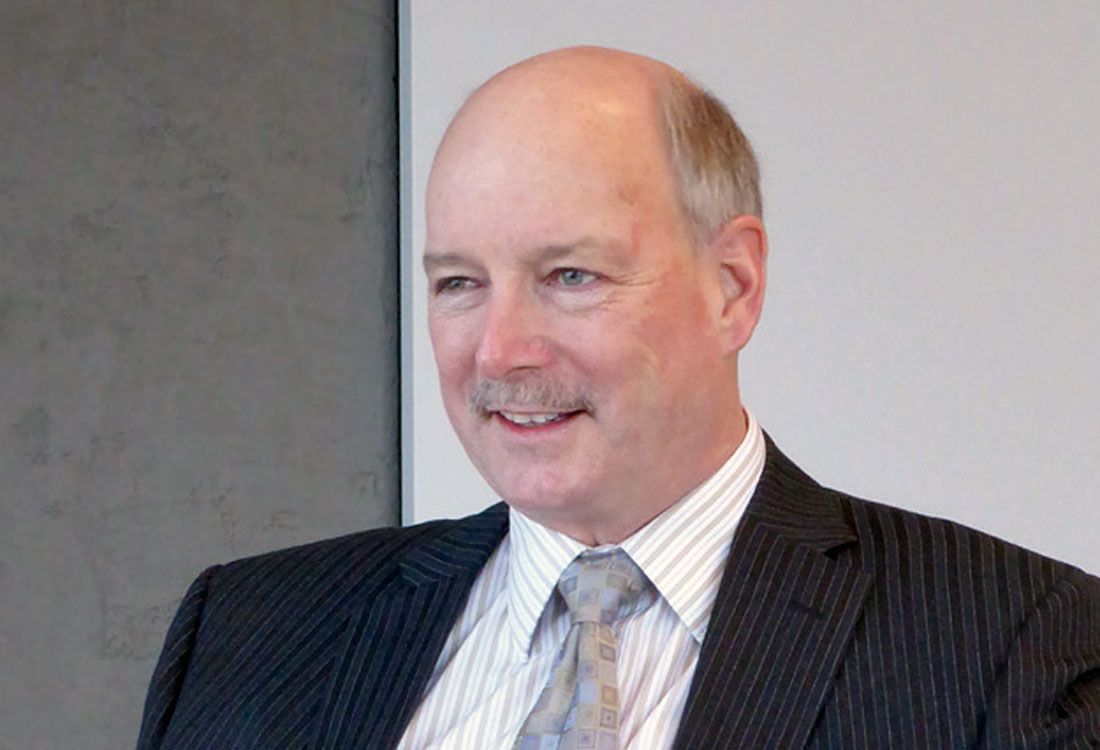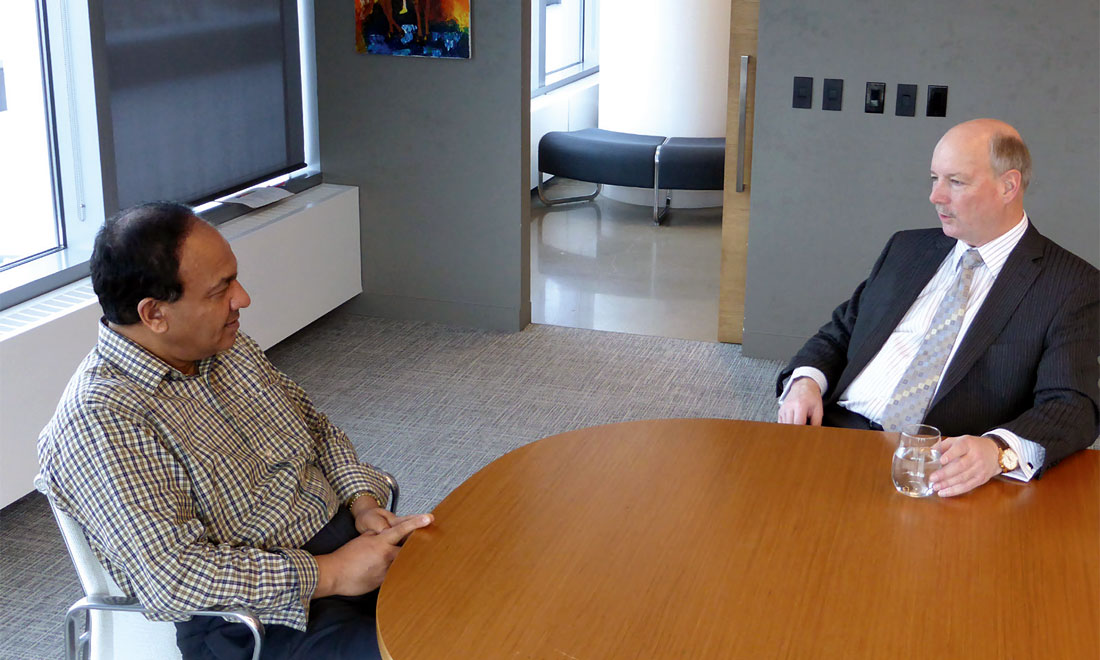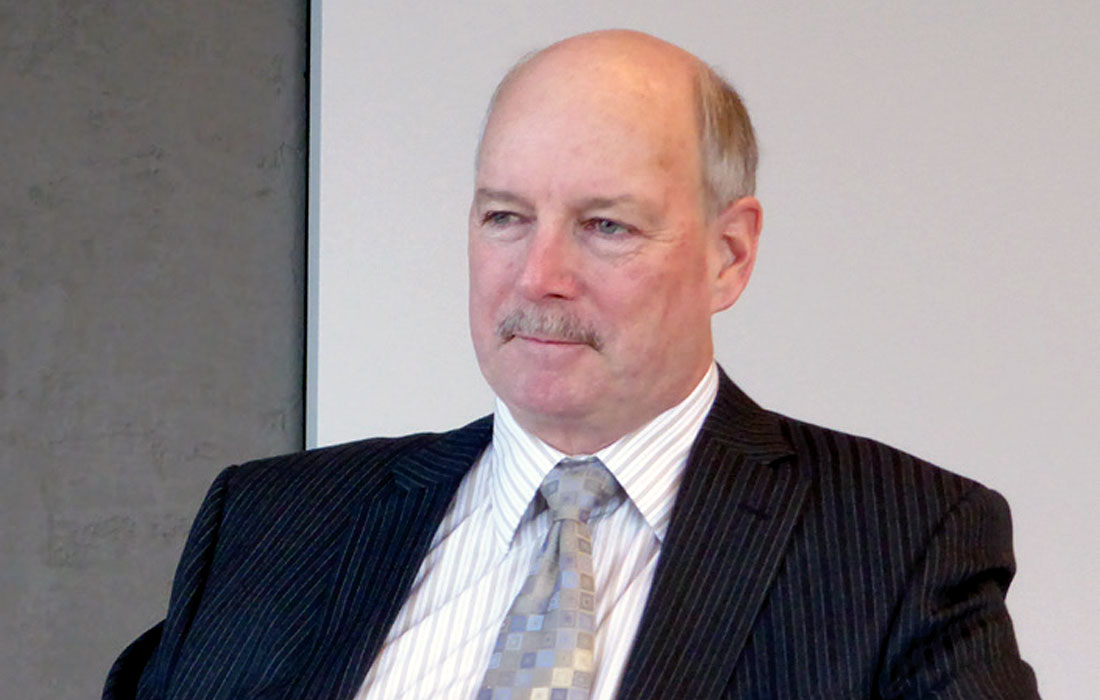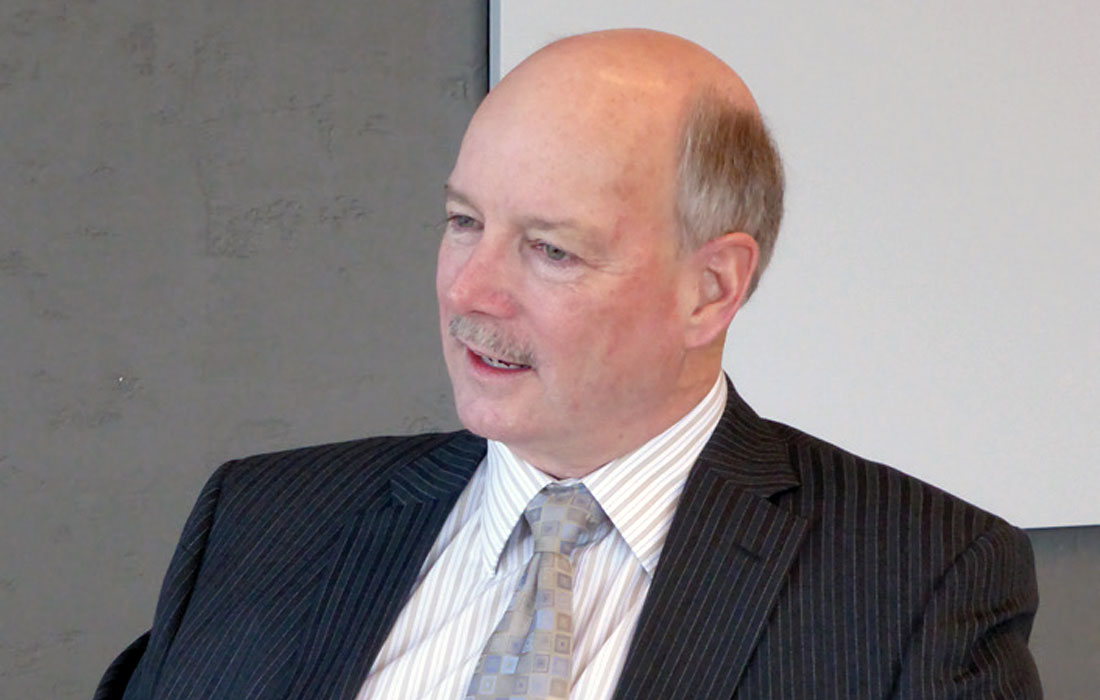
Could you tell us about your educational background and your work experience?
I did my B.Sc. (Honours) in Geological Sciences with Physics at Queens University from 1973-1977. That was the name Queens gave their geophysics program at the time. It was a full geology degree, the same as any other, but with all of the “elective options” used for additional physics and math courses. There was no real choice on the electives. Even the engineers at the time had more arts electives. It was a full geology degree, but also just short of the requirements for a physics degree and with a heavy concentration in mathematics.
After graduating with geological sciences and physics, how did you get into geophysics?
I was very much interested in the oceanographic side of geophysics. After graduating from Queens I headed to the University of British Columbia, to complete a masters degree in geophysics between 1977-1979.
I very much enjoyed the west coast lifestyle and during my time there managed to participate in a few oceanographic cruises. Unfortunately by the time I finished grad school, the major oceanographic institutions were either not hiring or were reducing staff due to budget cuts. Fortunately for me, I finished grad school as the oil industry was in a heyday and I had job offers from close to 20 companies, including all of the majors. I ended up choosing Imperial Oil, a partial subsidiary of Exxon at the time, because of the extensive training program they offered. They really focused on trying to make you into an all-round “explorationist”, with a series of six month assignments in geophysical, geological, petrophysical, and perhaps seismic acquisition and processing projects.
Apart from a short stint in processing of seismic data, you have spent the last 35 years of your life as a seismic interpreter. Tell us how you evolved as an interpreter, and decided that is what you would like to do for the rest of your life.
In the early 1980’s, I spent six weeks bopping around the Flemish Pass on an Exxon seismic vessel as the company representative. The source was quite unique, and involved 4 big gun sleds lowered by cranes (2 on each side of the ship). These huge inverted tanks were filled with a mixture of propane and oxygen and detonated every 9 seconds, day and night. It felt like depth charges going off, with the ships lights flickering at each shot.
This trip included some wild times on the “high seas”. The crew, myself included, had to recover and tie down the streamer cable and gun sleds in high winds and huge waves, when the ship passed through the tail end of a hurricane.
Later as a training assignment in Imperial Oil’s seismic processing group, I had the opportunity to process those same lines acquired in the Flemish Pass. Processing was quite different then and we used a big IBM 3030 mainframe. You prayed that your migration job, which would run all weekend, would be complete before IT shutdown the mainframe for their regular Monday morning maintenance!

Subsequently, in the mid-1980’s, after many other successful projects in the western Canadian basin, I joined Imperial Oil’s relatively small east coast team working primarily the Flemish Pass, Avalon Basin, and Scotia Shelf basins. I was in the rather unique position of interpreting the same seismic that I had acquired shipboard, and then processed. It was rare to be able to follow the data through from acquisition, processing, through to interpretation and drilling. I also had the opportunity to work with many talented Exxon colleagues who are well known for their contributions to seismic stratigraphy. I really enjoyed the challenges of predicting the stratigraphy in an essentially unexplored basin such as the Flemish Pass ahead of the drilling through seismic stratigraphy and system tract principles. This was more of an art form at the time and involved the wearing out of a great many coloured pencils!
What were some of the early landmarks in your career that put you on a sound footing in interpretation?
I was never shy about really getting to know new software. In the 1980’s in Imperial Oil, I was by far the most experienced in the company having worked the majority of the 3D surveys the company had at the time. Exxon had designed their own proprietary 3D seismic workstation technology at the time. I fondly remember pursuing pinnacles in the Rainbow-Zama play and early 3D studies over reef and bank plays which had been densely criss-crossed by 2D. It was remarkable and a real eye-opener on those early 3D’s what you learned about the long-producing fields on these new 3D’s in spite of the dense 2D seismic coverage. Myself as geophysicist and a geologist colleague (also now at Sproule), were rewarded by Imperial Oil for our success on the integrated 3D seismic/geological integrated interpretation and improvement in drilling success at Utikuma.
From 1990-1993, I was sent in part to teach Exxon’s North Sea staff advanced 3D seismic interpretation techniques and in part to be part of a small team having a higher level look at the entire northern North Sea. That evolved into being responsible for all the geophysics in the northern half of the North Sea including ~ ten producing fields (Brent, Cormorant, Tern, Eider, Osprey, Brent South, Stratspey, Dunlin, Pelican, and Hudson). It was a busy time in what was perhaps the North Sea’s heyday, choosing locations for up to 30 very expensive wells per year in these fields.
I spent another two years with Sirte Oil, also based out of London, working in North Africa and in particular the offshore Mediterranean, before returning to Calgary to join Photon: a geophysical software company as geosciences director.
Those early years in software development were fun, helping to use your interpretation expertise to improve the software and always hoping you were on the “leading edge” and not the “bleeding edge” of technology. Photon transitioned into CogniSeis and then Paradigm through ownership changes. I have many fond memories of travelling to all of the major conventions globally and show-casing the interpretation technology. After four years in the geophysical software side of things, it was time to get back into the fun of using the software to solve interpretation problems.
I joined Sproule as chief geophysicist in 1999 and soon became a partner. June 2014 will mark 15 years with the company. Now as vice-president of geosciences for the international division, I lead a very talented multi-disciplinary team of geoscientists, who work on a broad spectrum of projects all over the world. Sproule has worked essentially every oil and gas basin. I have had the pleasure to work geophysical projects in over 50 countries.
What has been your most challenging project?
Is there an easy project? Each has its own unique character and different challenges.
In your opinion, what is required for doing good and effective exploration?
Conceptualize a play; investigate if your hypothesis holds up to scrutiny using all available data; be prepared to modify your play models and try again.
Since you joined Sproule in 1999, you have been working more on international projects than the domestic ones. Could you please comment on that?
You are correct that I have had the pleasure of working a lot of international geophysical interpretation plays, in over 50 countries. These include Algeria, Argentina, Australia, Benin, Brazil, Canada (Saskatchewan, Alberta and British Columbia including WCSB, Foothills; Yukon, Northwest Territories, Beaufort Sea, Ontario, Quebec, East Coast), Brazil, Cameroon, China, Colombia, Côte d’Ivoire, Cuba, Czech Republic, Democratic Republic of Congo, Egypt, Ethiopia, Equatorial Guinea, Gabon, Germany, Hungary, India, Indonesia (Sumatra, West Java Sea), Iraq, Iran, Kazakhstan, Kenya, Kingdom of Tonga, Libya (Onshore and Offshore Mediterranean), Madagascar, Mexico, Mongolia, Morocco, New Zealand, Nicaragua, Nigeria (Offshore and Onshore), Norway (North Sea), Oman, Qatar, Russia, Sudan, South Sudan, Syria, Tanzania, Trinidad & Tobago, Tunisia, Turkmenistan, Ukraine, United Kingdom (Offshore North Sea and Onshore Weald and East Irish Sea Basins), United States (Alaska, California, Michigan Basin, Gulf of Mexico, Mississippi Salt Basin), Venezuela, Viet Nam.
The geophysicists, most senior petrophysicists, and geomodellers reside within my team in our international group. However Sproule shifts staff to focus on different projects as required. All of the above staff also work on a multitude of domestic projects. Although I’m a vice-president in our international group, I have enjoyed reviewing clients geophysical projects in all domestic regions from the Beaufort, Yukon and NWT, BC, Alberta, Saskatchewan, Manitoba, Southern Ontario, Quebec, Newfoundland and all major offshore discoveries in the maritimes. In a consulting firm, you get exposed to much more than you might in even a major operating company. You have the opportunity to absorb a great deal of brilliant work from such a wide variety of talented geophysicists and hope that some of the learnings rub off.
Last year my geoscience team worked projects in over 31 countries but also contributed to around 90 specialized studies in support of our domestic group. The geophysicists in our international group are also exposed a large variety of domestic projects annually, with perhaps more variety than they might in a typical operating company if they were an area geophysicist.
It is also important to remember that Mother Nature employs similar depositional principles whether it be the WCSB or some overseas basin. What you learn in one play area is also applicable elsewhere.
You have spent the last 14 years of your professional life working on international projects from almost all the continents. Based on your experience, tell us a little bit about the types of projects that you have carried out from each one of them.
As I have already mentioned, the variety of projects amazes me when I look back. Projects vary from grass roots exploration in essentially unexplored basins and basin-wide scale analyses to very detailed field development geophysics as input to geomodels and simulation models. You see a broad range of both clastic and carbonate plays types as well as some more unusual plays such as fractured Precambrian granites. The projects tend to be confidential and unfortunately there is little time to press the client for permission to publish before you are deep in the next project.
For efficiency’s sake, while perhaps waiting on data, my staff tend to carry several projects ongoing concurrently. That can pose some challenges until you get used to “switching gears”, as Monday you may be working New Zealand, Tuesday the North Sea, and Wednesday is Kenya… you get the idea
Do you think new geophysical technologies hold the promise of extraction of more information for characterizing hydrocarbon reservoirs? Do you use them in your interpretation for lowering of risk, so to say?
We are not a seismic processing shop. We do however receive a wide variety of “experimental” geophysical datasets to integrate within our interpretations. In a typical operating company, you may be experimenting with new techniques as you acquire new data over your assigned area of responsibility. In the consulting world, vast amounts of data, some experimental, are always coming in-house as part of the client evaluation. We tend to focus on making sense of that data in our overall geophysical-petrophysical-geological-reservoir engineering analysis and see what works and what doesn’t seem to be adding value. We have become pretty efficient at loading, assimilating, and integrating the data in short amounts of time. We do use different interpretation techniques rather than the conventional inline-crossline-timeslice style to help us more rapidly get through the heavy workload.
Having worked at Sproule for the last 14 years or so, tell us the advantages of working at a consulting company and the challenges that come with it.
I have worked in a major, both domestically and internationally, geophysical software companies, and on the consulting side. I would say of the three, I certainly favour consulting. As an area geophysicist in an operating company, you may work the same allocated turf for several years before management moves you to a different area with perhaps different play types.

In the consulting world, projects come in on a regular weekly basis from different basins all over the world and various parts of Canada from the east coast to BC. Some you work up from scratch yourself, while others you review the clients work. It depends on the nature of the project. You get to see a lot of client interpretations and techniques from a wide variety of plays. Some of the clients’ interpretations are incredibly good, and some not so. Some are clastic plays while others are carbonate, the geophysical interpretations may vary from broad scale basin analysis to excruciatingly detailed reservoir geophysics tying into 3D geomodels and simulation models. Some may involve tremendously complex faulting while others are very subtle stratigraphic plays. In short, you get exposed to a lot of geophysical interpretation styles and techniques. The greatest satisfaction is when you can add value to the client by enhancing what was received or satisfaction from an integrated study developed from scratch.
Going by what all you have just mentioned, you have been a successful seismic interpreter. What would you say is required to become one?
A strong geology background and understanding of depositional systems. After all, what you are doing as a seismic interpreter is trying to “see” the geological story and the potential in an incomplete media.
After 35 years of experience under your belt now, what influences you and your work?
I have a very talented team of geophysicists, petrophysicists, geologists, and geomodellers in my group and we work closely with a very large diversified group of engineering colleagues. I take great pride in the growth of those individuals as geoscientists. The variety of projects we work on is amazing and I am always learning about new basins, their geology, and plays. That keeps things fresh and exciting.
Is there anything left for you to be achieved professionally and personally?
I am still always learning. My plan is to give a greater percentage of my time mentoring young geophysicists. Family wise, it is helping my three sons progress as young men as they move on in their lives.
There is a certain amount of creativity that is required for doing effective seismic interpretation. Do you agree with that statement? Do you think many seismic interpreters lack creativity? What is required to be creative?
Interpreters should attempt to broaden their experiences. Canada has a reputation for producing some of best interpreters. Domestically, we typically work on very subtle plays, pushing the envelope of what can be detected. However, if you give that experienced interpreter who has been perhaps working on subtle channel plays much of his career a very complexly structured offshore play with a huge and numerous major fault throws, he might not have the experience or background in his interpreter’s “toolkit” to know best how to proceed. Conversely, the interpreter experienced in complexly structured plays may look at a typical Western Canadian Basin line and struggle to see anything of interest. Different interpretation projects require an interpreter to broaden his skill set.
Barrie, please permit me to ask you this: What differences did you notice when you turned 30 years, 40 years and 50 years old? As an example, some people think 30s allowed them to experiment with options, 40s gave them time for self-introspection, and so on. Your comments?
When in my 30’s, I was too focused on perfection. Everything had to be just so with no perceived flaws.
My 40’s was more a time of experimentation, developing geophysical software that most interpreters didn’t realize that they needed.
As I grew in experience, it became more apparent that there are a lot more grey areas where you just do the best you can under the time and budget constraints you face in order to maximize the value of the advice you provide to the client.
As you progress in your career, take pride in the growth of those that you are mentoring. It’s almost like raising kids… when you see some young interpreter gain confidence in their general skills, excelling at some, and working independently with only a little guidance now and then.
Barrie, you a registered member of APEGA, P.Geoph. Why did you think it was necessary for you to become a member of APEGA?
Every oil and gas firm needs to have a registered “responsible member” in the various disciplines (geology, geophysics, engineering) and I fulfill that role for geophysics at Sproule.
A core part of our business is reserve / resource evaluations. In order to be a qualified reserves evaluator, I must also be registered with APEGA in order to sign our clients reserve evaluations. APEGA serves a different purpose than other professional /technical associations I belong to (CSEG, SEG, CSPG, AAPG, EAGE, PESGB, IPA).
What are your other interests?
I have place on Vancouver Island with not only a wonderful ocean view, but also a spectacular 180 degree panorama of the mainland and coastal mountain system. That is my favourite place to spend time, eventually retire to, and plan to focus more on exploring the west coast, and in particular the Desolation Sound and parts north by boat.
What would be your message for young entrants in our industry?
Don’t be afraid to push the technical limits of the current software you employ. From my days in the software industry and observations as a consultant, I see a lot of geophysicists stopping far short of what they could do as they are only comfortable doing the basics. Many geophysicists only utilize a small fraction of the tools they have at their disposal.
As an example, I had a client in a major oil and gas company that spent months picking a subtle channel play that meandered as it dropped in time, bifurcated into several main wandering branches and eventually became very dendritic. He was trying to painstakingly pick the dipping channel on inlines, crosslines, and timeslices. I knew he had a 3D visualization package that my company at the time had sold to his firm and asked why he hadn’t tried to use that over the past months? His response was that it was far too subtle, that he had to pick each small “channel blip” on a line by line basis. It took only a short time for me to load the 3D seismic into the visualization package, voxelfilter the entire SEGY volume to identify and isolate the channel in 3D space, plant a single seed point into the channel, play around with the voxel search parameters for the 26-way search detection. Within a few minutes, the entire channel was picked in far greater detail and the “sweet spots” of the channel were then identified for further analysis. Sometimes trying new interpretation techniques can save time and produce better results.

Another suggestion is to go beyond traditional top and base horizon and fault interpretation. We have the capabilities to rapidly create a wide variety of 3D seismic attribute volumes. I see many interpreters fall short at extracting the most information from these. Rather than focusing on simple horizon attributes, try to spend more time on interval attributes. If the reservoir is thick enough, isolate the reservoir interval as a formation sculpted body floating in your 3D visualization software. It is far better to voxel-filter the amplitudes to reveal the geology and depositional trends for the entire reservoir interval than to make simple horizon-based amplitude extractions. Multiple 3D volumes for a formation-sculpted “reservoir interval” can be colourblended to enhance the visualization, whether it be clastic depositional systems (dunes, alluvial, fluvial channels, crevasse splays, fans, shorelines, point bars, etc), carbonate buildups, or for better fault and fracture detection. You may find you see the geology, the depositional systems and structuring, in a whole new way and get better insights.
As the younger geophysicists progress to team lead and middle management rolls, I would advise that they keep their interpretation skills. It remains my favourite activity and it will keep them more employable during the inevitable industry down-turns.











Share This Interview